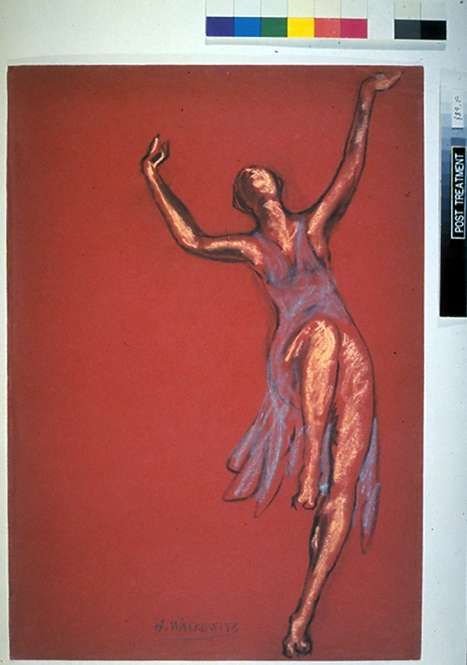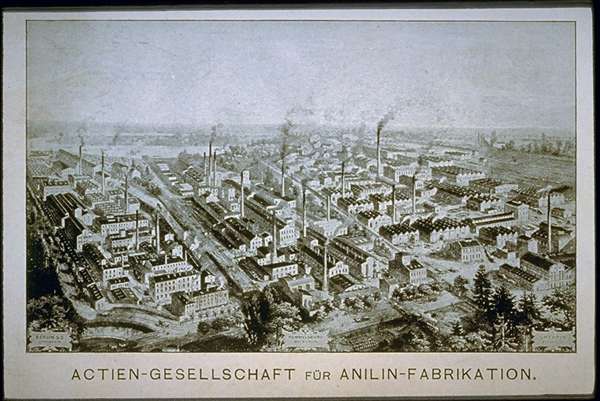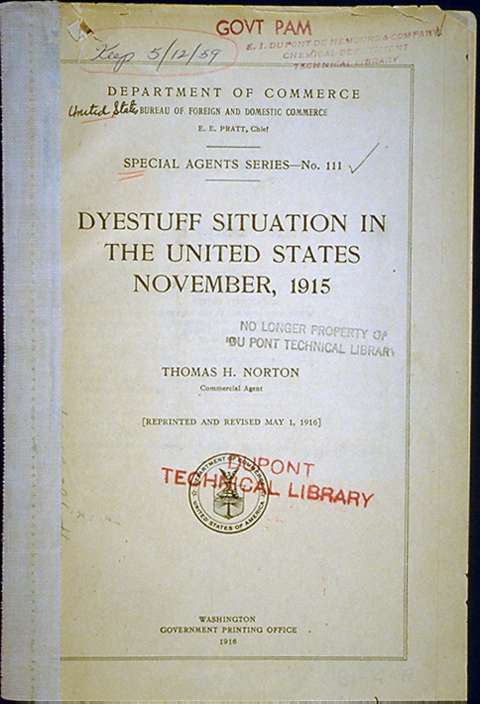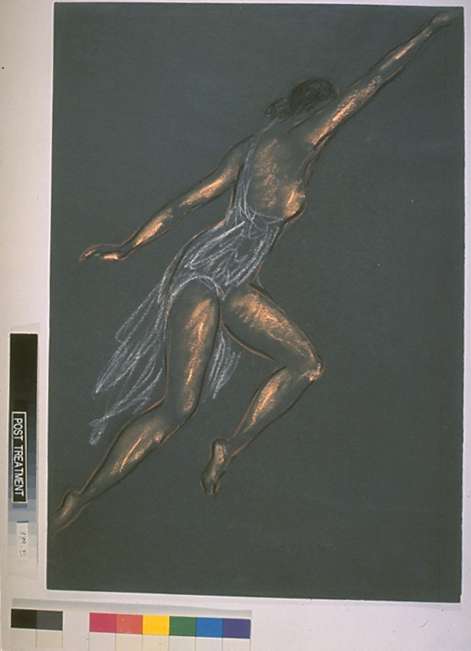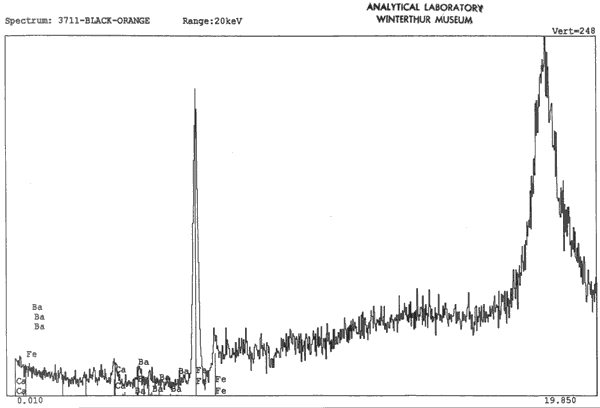Construction Paper: A Brief History of Impermanence
by Joan IrvingIntroduction
All of us have a great deal of intuitive knowledge about construction paper. We have cut it, pasted it, made festive paper chains, and, sadly, occasionally, watched our creations fade and disintegrate over time. Despite its apparent impermanence, construction paper made its way from kindergarten classrooms to artists' studios where it was used as a primary support, as a collage material, and as an artist's mount or secondary support. It was used by artists such as Abraham Walkowitz, Jackson Pollack, and Robert Motherwell, to name just a few. Now, of course, it is often found in the paper conservation laboratory. Its condition is often brittle, due to its wood pulp furnish, and its colors (if there at all) are faded. Though its problematic nature leaves few options for treatment, there is some hope with preventive care.
Fig. 1. Abraham Walkowitz. [Isadora Duncan], c. 1915. Pastel on construction paper. University of Delaware.
My interest in construction paper began when, as a conservation student, I was presented with a group of pastel drawings on colored papers by the 20th century artist Abraham Walkowitz in the collection of the University of Delaware (fig. 1). These medium-weight, colored, wove papers resembled what is commonly called construction paper. They were in remarkably good shape, having been handled and exhibited very little, if at all. the colors were still quite rich, only minimally faded and brittle at the edges.
This paper will offer a brief history of the origins and manufacture of early 20th century construction paper, and, given the Walkowitz papers, hope for some degree of stability with appropriate housing and storage. for the purposes of definition, construction paper will refer to the relatively inexpensive, machine-made, wove, wood pulp papers that are dyed in the vat with synthetic, organic colorants.
Colored Papers in the Classroom
The term construction paper likely has its roots in the classroom, where the making-of-things and where learning how-things-are-made were closely linked to the use of educational colored papers. the terms "school papers," "poster papers," and "colored school papers," found in several early 20th century paper trade dictionaries, describe a type of paper that fits the definition of construction paper. A more recent definition in the Dictionary of Pulp and Paper (1980) describes the paper as "a school paper used for cut-outs, crayon drawings, watercoloring, fingerpainting, etc. It is usually made from mechanical wood pulps."
In the late nineteenth century, a genre of colored educational papers were marketed to teachers in school supply catalogues (Andrews 1878, Babb 1897-98). the J.L. Hammett Co. catalogue (1895) of kindergarten supplies describes a variety of colored papers, and distinguishes between those colored papers that are coated and those that are "engine colored," or colored in the vat (Hammett 1895). the advantages of these "engine" or beater-colored papers are numerous. the Hammett Co. asserts that the "colors are mixed with the pulp of the paper, in the process of manufacture, and cannot be rubbed off by moisture or otherwise..." (Hammett 1895). These papers, according to the catalogue, are equally colored on both sides and are particularly suitable for folding. Importantly, the green colorants -- unlike some which were available -- do not pose a health risk because the dyes or "stains" are arsenic-free.
The making of colored constructions was serious business in the late nineteen century -- not at all related to the making of holiday ornaments and paper valentines. the kindergarten curriculum included elementary color theory, which promoted the use of prisms, color wheels, and colored papers. the Bradley Scheme of Color Instruction, for instance, espoused an educational theory "based on the adaptation of the scientific laws of color as discovered in nature to the analysis and combination of pigmentary colors in art" (Hammett 1895).
To complement the theoretical, hands-on experiments in color were offered to children in the form of "occupations" or "gifts." These "gifts" were formally defined and numbered, and they included a variety of projects such as folding, embroidering, perforating, and weaving colored papers. the thirteenth gift, for example, is devoted to paper cutting. According to the A.H. Andrews (1878) catalogue, the gift is a kit that included a supply of colored paper squares that children were instructed to cut and fold in various symmetrical designs. the Hammett catalogue description of the thirteenth gift later added that "the child's propensity to destroy with scissors is here guided so ingeniously as to produce wonderful results."(Hammett 1895). the exercises in this gift were to be repeated, and samples retained and monitored for progress over time.
While it is clear that much construction was taking place in the classroom, the term "construction paper" was finally linked to a type of art educational paper, as well as artists' paper, in the early 20th century. in the Prang Company supply catalogue (1911), "Tinted Drawing and Construction Papers" were advertised. the catalogue description states that the papers are "suitable for pencil, charcoal, crayon, watercolor and construction work. Used with water color or with colored crayons they produce particularly attractive results. They are also extensively used for mounting drawings and designs, both in black and white and color." (Prang 1911).
Colored Papers in the Studio
Prior to the availability of synthetic dyes, or the "engine colors" mentioned in the school catalogues, artists and papermakers had been applying color to papers with pigment and with a variety of vegetable dyes and stains for centuries. Blue-colored papers, for instance, were made in the Near East and Asia from the Middle Ages (Brückle 1993).
In England, blue papers as well as drab colors were manufactured in paper mills. in 1796, Thomas Cobb patented a method of dyeing pulp based on the principles of textile dyeing. Cobb's finest papers were dark tones, primarily deep browns and olive colors (Krill 1987). in England, artists working in watercolor, such as Turner, could select from a variety of blue, brown and drab, or Cobb papers, as they would come to be called through the 19th century. Some of Turner's blue papers had their origins in commercially produced sugar loaf wrapping papers (Bower 1990). and so, the use of colored papers by artists -- even ones with industrial origins -- was hardly news in the early 20th century.
Pastel artists, too, were working with colored papers in the 18th century, if not before. Instruction manuals encouraged them to select from a variety of muted grey and blue tints for pastel and chalk (Goupil). in the late 19th century, with the industrialization of paper manufacture and with the new aniline dye technologies, a variety of inexpensive colored papers were available. As pastel experienced a rebirth of popularity in America at the end of the 19th century, artists were able to choose from a variety of tinted artists papers as well as cheaper commercially produced charcoal and cartridge papers, mottled papers, sandpapers, and colored papers (Shelley 1989). the use of cheaper, commercial colored papers can be seen, for example, in the green laminated paperboard of Mary Cassatt's Woman on a Bench and in the brown machine-made wrapping paper of Edwin Austin Abbey's Dirge of the Three Queens (Shelley 1989). Though Abraham Walkowitz's selection of deep red, brown, and green construction papers for his pastel drawings was in keeping with prevailing trends, the method of manufacture of these papers was new -- and untested.
In the 20th century, the ready availability and range of colors of construction paper tempted numerous artists. for example, construction paper is found as a mount for two paintings on paper by Marc Chagall in the collection of the Metropolitan Museum of Art Both construction papers, removed from the primary supports and retained, show characteristic symptoms of deterioration. One mounting paper, now grey, exhibits the brown oxidative discoloration at the edges typical of these papers. in another Chagall mount, areas of construction paper concealed under the primary support reveal a deep red color. Unprotected boarders have shifted to brown. Both exhibit minor mottling -- a result of the dyeing process and of uneven fading due to the mixed fiber furnish. the color shift is even more dramatic in another Chagall work mounted on construction paper, where the pale violet color has shifted to a warm tan. All of these mounts, incidentally, were chosen by the artist, as indicated by a comparison of manuscript notations on the mount with the artist's signature (Ellis 1997).
Not surprisingly, given the range of colors, construction paper was also used as a collage material. Abstractionist Gertrude Green's collage entitled Composition, in the collection of the Philadelphia Museum of Art, exhibits distinct color changes. in this work, overlapping collage elements and adhesive accretions protected some areas of construction paper from light. the protected areas indicate color shifts from green to brown and from a cool tan to warm tan. It is difficult to say whether or not George Bunker's 1956 collage entitled in the Quarry, in the collection of the Museum of American Art, was intended as a largely monochromatic study of brown and tan. Comparisons with other works by the artist suggest otherwise, since Bunker favored subtle but discernable differences in hue. Since the collage is thickly varnished all over, there is no peaking under flaps to ascertain color shifts.
If a collage element happens to become detached from the primary support, as in the case of a collage by Ilya Bolotowsky (The Metropolitan Museum of Art), obvious color shifts in both the attachment and the secondary support were evident. the point here is not about what specific color changes occurred and where, but that artist's intent is no longer discernable -- but by peeking or by happenstance. and so, with these construction paper works, artist's intent is hidden by the effects of light and time.
Immediacy of expression, rather than colorfastness, was an essential component of the work of Jackson Pollack. Pollack used orange construction paper as a primary support for a design rendered in black ink, Untitled, 1943, in the collection of the Hirshhorn Museum and Sculpture Garden. Antoinette Owen has described losses of paper due to the extreme brittleness and fragility of the paper (Owen 1986).
By mid-century, the lack of color permanence of construction paper could not have been much of a secret. Matisse's cut outs for the book Jazz (1947) were made from Canson and Montgolfier papers coated with Linel's Gouaches Extra-fines. This method was chosen, in part, because of the colorfastness of the pigments (Perry 1994).
Manufacture: Pulping and Dyeing
All construction papers, whether found in the classroom or in the artist's studio, have their roots in the late nineteenth century--when the nascent technologies of industrial wood pulp paper manufacture and synthetic organic dyes met in the vat.
Early 20th century construction papers were made largely from softwood fibers, mechanically and chemically pulped. in terms of chemical pulping, the sulphite process was commonly used for low-grade papers such as newsprint, cheap magazines, and "poster" papers (Roberts 1924). Sulphite pulps were made by cooking low resin softwood chips under pressure at elevated temperatures in a solution of calcium, magnesium, or ammonium bisulfite (Browning 1977). Spruce, balsam fir, and hemlock were typically used. Smaller quantities of hardwoods, such as poplar, were sometimes used. Groundwood was added to sulphite pulps in varying proportion, depending on the quality of the end product. the sulphite process was the predominant pulping mode in the U.S. until about 1930.
The Manufacture of Pulp and Paper textbook (Brassington 1929) describes construction paper or "poster paper" as a "colored newsprint" that is lightly sized and composed of approximately 50-70% groundwood, with the remainder of unbleached sulphite pulp. This is consistent with fiber analysis of several Walkowitz drawings, which though undated, probably range from 1910-1920. Examination of the fibers under magnification (100X), revealed the presence of softwood fibers, whose color range and morphology suggested unbleached sulphite (Mayer 1993). Microchemical testing (Graff C-Stain and A-20 Stain) showed positive reactions for unbleached sulphite. (Mayer 1993) These findings are supported by fiber scientist Walter Rantanen (Supervisor, Fiber Science Group,
Integrated Paper Services, Inc.), who added that early construction papers also included small amounts of cotton and bast fibers (Rantanen 1993). This is also supported by two of the Walkowitz papers, which included a small amount (less than 5%) of cotton (Irving 1993, Knipe 1996). These fiber furnishes remained relatively consistent until about 1960, according to Rantanen, when sulphate or Kraft processing eclipsed sulphite manufacture of these papers.
Aniline Dyes
The marriage of pulp and dye is the critical factor in the history of early construction papers. the new aniline dyes were relatively inexpensive and had high tinctorial strength, which made them ideal for industrial pulping processes such as sulphite. in addition, they offered a wider range of colors than pigments and vegetable dyes -- which generally had lower tinctorial strengths.
Fig. 2. Berlin Aniline Works c. 1904. Hagley Museum & Library Pictorial Collections.
The first aniline dyestuff, the color mauve, was developed by Sir Henry Perkin in 1856. His serendipitous discovery occurred during attempts to manufacture synthetic quinine by the oxidation of aniline oil. Aniline dyes were used extensively in the textile industry after 1856, though their use in the paper industry was minimal until about 1890. (Tucker et al. 1924). the aniline dye industry flourished in Europe, particularly in Germany, from about 1890 to 1914. the Germans recognized, early on, the importance of an industry which would yield good profits during peacetime and which could readily be converted to the manufacture of munitions during war (fig. 2). Since aniline dyes were synthesized from coal tar, crude products could yield a variety of intermediates ranging from dyes to explosives to poisonous gases (Tucker et al. 1924).
Fig. 3. The Dyestuff Situation chronicled the "dye famine" and its impact on the consumption of aniline dyes in the U.S. Hagley Museum & Library Pictorial Collections.
The Germans heavily subsidized this industry in the late 19th century and monopolized the market up until about 1880. From about 1880 to 1914 a few American companies were making aniline dyes, but could not really compete with the subsidized companies of Central Europe. When war broke out, German exports of dyes ceased. the "dye famine," as it was called, was described in a U.S. Department of Commerce bulletin, published in 1916 (fig. 3). the early months of 1915 were reported as follows: "The possibility of a complete cessation in shipments was, however, constantly present as a menace, hanging like the sword of Damocles over the head of every consumer of synthetic dyes. the threatened danger arrived eight months ago, when an embargo on the shipment of dyes of German origin to neutral countries came into effect. Since March 15 [1915] no wares in this category have been received.... This deadlock still exists." (Pratt 1916).
Fig. 4. Abraham Walkowitz. [Isadora Duncan], c. 1915. Pastel on construction paper. University of Delaware. Analysis of this brown construction paper revealed the presence of an iron pigment.
Fig. 5. XRF Analysis indicates the presence of the iron-based pigment sienna. The Winterthur Museum Analytical Laboratory.
So what were American and other "neutral" paper manufacturers doing about coloring paper? During the war years, pigments and vegetable dyes which had not been used for years (at least not on a large industrial scale) reappeared on the market, due to the scarcity of aniline dyes (Tucker et al. 1924). One of the Walkowitz construction papers, dark brown in color (fig. 4), appeared under magnification (100X) to be pigmented rather than dyed (Mayer 1993). the dark brown and black particles of pigment appeared between paper fibers which, themselves, were not highly colored. Energy Dispersive X-Ray Fluorescence (XRF) analysis conducted by Winterthur's Senior Scientist Janice Carlson, indicated the strong presence of iron (fig. 5). the analysis suggested much more than trace amounts of iron than would ordinarily be found in such a paper. the iron was present without manganese, indicating that the pigment is sienna (Carlson 1997). While one test cannot conclusively indicate a date during the "dye famine" of the War years for the manufacture of this paper, it does add one more piece of evidence that may suggest a mid-teens dating. This is certainly supported by historical information about Walkowitz's acquaintance with Isadora Duncan and with stylistic comparison with other drawings of Duncan, which incidentally number nearly 3,000. Most were produced during a twenty year period from about 1910 to 1930.
The presence of pigment may also indicate why these drawings still look so well. While clearly some dyes are present, perhaps they were significantly supplemented with pigment. Further analytical testing of the collection with both XRF, for the presence of inorganic pigment, and possibly thin-layer chromatography, for the presence of synthetic organic dyes, would be good avenues for future research. As far as the history of aniline dyes (and the development of an American technology) is concerned, things were looking up by the mid- 1920's. Company's with names such as DuPont, Goodyear, Monsanto, and
Sherwin-Williams were putting lots of money into research and development. DuPont, in particular, was quite aggressive in the R & D department, luring German scientists to Delaware with big salary incentives (Hounshell and Smith 1988).
The dye situation was still somewhat precarious, however, in 1920, as suggested by a Milton Bradley company catalogue for school supplies. Under an advertisement for "Bull's Eye" papers, indexed under the term construction paper in the back of the catalogue, is this disclaimer: "Owing to the uncertain condition of the dye market, the prices on this paper are continually fluctuating. We therefore suggest that you write for the prices." (Bradley 1920).
There seemed to be no uncertainty by 1924 at the DuPont Company. the 1924 publication entitled the Dyeing of Paper, (Roberts 1924) included dozens of aniline dyes designed for a variety of end uses. A description of "poster paper" offers a recipe of unbleached sulphite pulp that is sized with alum and includes dozens of dyed construction paper samples. By 1924, the McGraw Hill textbook entitled the Manufacture of Pulp and Paper, described and illustrated numerous American technological advances in the dyeing of paper (Tucker 1924). in particular, attention was given to American methods of preparing sample papers for testing paper strength, color, and fastness to light, water, alkali, and chlorine.
The most common of the aniline dyes used for coloring paper pulps were the basic, acid, and direct dyes. Basic dyes were the most important type of water-soluble dyes used in coloring paper. They had the advantages of low cost, high tinctorial strength, and brilliance. Basic dyes are the salts of color bases, and generally appear as chlorides, hydrochlorides, sulfates, oroxalates (Smook 1982). the dyes attach to non-cellulosic impurities, such as lignin, present in the paper (Britt 1964). Basic dyes have a strong affinity for unbleached sulphite pulps, which contain sufficient amounts of lignin to combine with the dyestuff (Tucker et al. 1924). These dyes have a somewhat lesser attraction for groundwood pulps, where the lignin is less accessible to the dye molecule. (Tucker et al. 1924). Basic dyes have little affinity for bleached pulps, however, since much of the lignin is removed during processing (Britt 1964). Basic dyes are prone to mottling in mixed furnishes of bleached and unbleached pulps and even in the standard mix of unbleached sulphite and groundwood pulps. in the latter, the mottling is controlled in the vat by keeping temperatures low and by first dyeing the more resistant ground wood pulps before adding the unbleached sulfite pulp. (Roberts 1924). As a class, basic dyes have poor fastness to light, acids, alkalis, and chlorine (Smook 1982). Basic dyes are generally quite soluble in warm alcohol (Britt 1964).
Acid dyes are sodium salts of relatively low molecular weight sulfonic acids. Direct dyes are similar compounds of higher molecular weight (Britt 1964). Acid dyes are usually preferred for surface coloring because of their lack of preferential affinity for certain fibers. Though they do not produces mottled fibers, acid dyes have little or no affinity for cellulose and require mordants such as size and alum. These dyes have better light stability than basic dyes, though they generally produce duller colors. Direct dyes, by contrast, will dye the fiber without the use of mordants or dyeing assistants. Direct dyes produce somewhat muted tones and are used for absorbent tissues, such as facial tissue, where size and alum are not used (Britt 1964).
The dyes used for the Walkowitz construction papers are likely the product of basic and acid dyes. A listing of construction or "poster papers," composed of unbleached sulphite furnish, published in the Dyeing of Paper, shows that approximately 60% of the colors were basic dyes, with the remainder largely acid colors (Roberts 1924). Basic dyes were used for various blues (DuPont Victoria Blue), reds (DuPont Safraninen T), yellow (Auromine O), green (Victoria Green), magenta (DuPont Methyl Violet NE and Fuchsine Powder) and brown (DuPont Basic Brown). Acid dyes were used for shades of orange and yellow, in better grades of paper. the basic yellow, Auromine O, was considered suitable for cheaper consumable papers, such as wrapping papers, which required little lightfastness
(Roberts 1924). At times dyes were used in combination to optimize lightfastness and brilliance. Pulp was sometimes dyed with a bottom of acid color and topped, after sheet formation, with a basic dye. This color lake produced a richer color than could be made by an acid dye alone, and also produced a relatively more permanent color (Roberts 1924). the basic dye Auromine O, for example was typically used to top acid oranges and for shading basic browns, blues, and greens (Roberts 1924).
Conclusion
The history of construction paper can be summed up so well by Deborah Harry's hit song "Radiate and Fade Away." the vibrant basic dyes and deeper acid dyes found numerous applications -- though their visual shelf-life was quite short. the exciting colors made possible by the aniline dye technology, and the cheaper papers made possible by sulphite processing, met the needs of unsuspecting artists working in a variety of modes. It wouldn't be surprising in a contemporary context, where materials such as pressure sensitive tapes and staples are used with intent, to find construction paper once again -- exhibiting its usual self-destructive tendencies. and so, despite what we now know about the perils of construction paper, it has shown up and will, no doubt, continue to appear in a variety of collections.
Given the sensitivity of aniline dyes to water, alkali, and alcohol, there is little option for aqueous treatment. in fact, some aniline dyes can be sensitive to the high relative humidities often used during relaxation treatments. Surface cleaning, too, poses a problem since the soft, felt-like surface of these papers is prone to abrasion. and so, treatment options for most construction papers is limited. However, physical support of these delicate papers should be a high priority. Construction papers should be handled as little as possible. To protect brittle edges, objects should be placed in sturdy 4-ply or 8-ply 100% ragboard mats. Since the aniline dyes are sensitive to alkali, the mats should be of unbuffered or neutral pH paperboard. If only buffered housing materials are available, the object should be interleaved with a neutral pH paper, so that it does not touch the alkaline paperboard. Most colors are quite sensitive to light, though some aniline dyes have been known to fade even in the dark. A conservative approach to light exposure is advisable, particularly since the degradation reactions of the ligneous papers are also catalyzed by light. While some of these papers will self-destruct even in the best of environments, the still-rich colors of the Walkowitz drawings are a sign of hope.
Acknowledgments
The author would like to thank the following institutions and individuals for their valuable contributions to this paper.
Conservation Center for Art and Historic Artifacts (CCAHA)
National Endowment for the Arts, Advanced Internship in Paper Conservation
Janice Carlson
H.F. DuPont Winterthur Museum & LibraryMargaret Holben Ellis
Conservation Center, Institute of Fine ArtsBetty Fiske
H.F. DuPont Winterthur Museum & LibraryJohn Krill
H.F. DuPont Winterthur Museum & LibraryDebora Mayer
Conservator in Private PracticeMary Schobert
CCAHA, Internship SupervisorTed Stanley
Princeton University Libraries
References
Andrews Co., A.H. 1878. The Child's First Drawing Book. Chicago: A.H. Andrews Co.
Babb, Edw. E. 1897-98. Illustrated Catalogue of School Supplies. Boston: Edw. E. Babb & Co.
Bower, Peter 1990. Turner's Papers: A Study of the Manufacture, Selection and Use of his Drawing Papers 1787-1820. London: Tate Gallery.
Brassington, J.W. et al., 1929. The Manufacture of Pulp and Paper: A Textbook of Modern Pulp and Paper Mill Practice, Vol 5. New York: McGraw-Hill Book Company, Inc.
Britt, Kenneth W, ed. 1964. Handbook of Pulp and Paper Technology. 2d ed. New York: Van Nostrand Reinhold Company.
Browning, B.L. 1977. Analysis of Paper, 2d ed. New York and Basel: Marcel Dekker, Inc.
Brückle, Irene 1993. "The Historical Manufacture of Blue-coloured Paper". The Paper Conservator, Vol. 17: 20-31.
Carlson, Janice. 1997. "Energy Dispersive X-Ray Fluorescence Analysis." Wilmington, Delaware: the Winterthur Museum Analytical Laboratory.
Dictionary of Paper 1980. The Dictionary of Paper: A Compendium of Terms Commonly Used in the U.S. Pulp, Paper, and Allied Industries. 4th ed. New York: American Paper Institute, Inc.
Ellis, Margaret Holben 1985. "The Precarious Life of Drawings." ARTnews Vol. 84, No. 10 (December): 81-85.
Ellis, Margaret Holben 1997. Personal communication.
Goupil, F. A. 189[]. Treatise on Pastel Painting. Translated and revised by S.M., 3d ed. Philadelphia: F. Weber and Company.
Hounshell, David A. and Smith, John Kenly 1988. Science and Corporate Strategy. Dupont Research and Development, 1902-1980. Cambridge: Cambridge University Press.
Hammett, J.L. 1895. Illustrated Catalogue of Kindergarten Materials... Boston: J.L. Hammett.
Irving, Joan 1993. Condition Report and Addendum (889.E and F). Unpublished typescript. Wilmington: H.F. DuPont Winterthur Museum & Garden, Conservation Office.
Krill, John 1987. English Artists' Papers: Renaissance to Regency. London: Trefoil Publications Ltd.
Knipe, Penley 1996. Independent Study: Walkowitz's Colored Papers. Unpublished typescript. Wilmington: H.F. DuPont Winterthur Museum & Garden, Conservation Office.
Mayer, Debora D. 1993. Fiber Examination and Personal communication.
Milton Bradley Company 1920. Bradley's School Materials and Books. Springfield, Massachusetts: Milton Bradley Company. 57.
National Aniline & Chemical Company 192[]. Dyes for Paper. New York: National Aniline & Chemical Company.
Owen, Antoinette. Modern Materials in Drawings Part II - Supports. Drawing. Vol 8, No. 5 (January - February): 102-104.
Pratt, E. E., Chief, Department of Commerce 1916. Dyestuff Situation in the United States, November 1915. Washington, D.C.: Government Printing Office.
Perry, Roy A., 1994. "Paper in Modern Art." Modern Works - Modern Problems? Conference Papers, the Institute of Paper Conservation, New York.
Prang Company. Art Catalogue [1911]: A Catalogue of Books and Materials Prepared for the Promotion of Art Education in the Schools. 2d ed. New York: Prang Company.
Rantanen, Walter 1993. Personal communication from Integrated Paper Services, Inc., Appleton, Wisconsin.
Roberts, John R. 1924. The Dyeing of Paper. Wilmington: E.I. duPont de Nemours & Co., Inc.
Shelley, Marjorie 1989. "American Pastels of the Late 19th & Early Twentieth Centuries: Materials and Techniques." American Pastels in the Metropolitan Museum of Art. New York: Metropolitan Museum of Art.
Smook, G.A., author and Kocurek, M.J., editor, 1982. Handbook for Pulp & Paper Technologists. Atlanta: TAPPI and Montreal: Canadian Pulp and Paper Association.
Tucker, E.C. et al., 1924. The Manufacture of Pulp and Paper: A Textbook of Modern Pulp and Paper Mill Practice, Vol. 4. New York: McGraw-Hill Book Company, Inc.
Joan IrvingConservator
Conservation Center for Art and Historic Artifacts
Publication History
Received: Fall 1997
Paper delivered at the Book and Paper specialty group session, AIC 25th Annual Meeting, June, 1997, San Diego, California.
Papers for the specialty group session are selected by committee, based on abstracts and there has been no further peer review. Papers are received by the compiler in the Fall following the meeting and the author is welcome to make revisions, minor or major.
